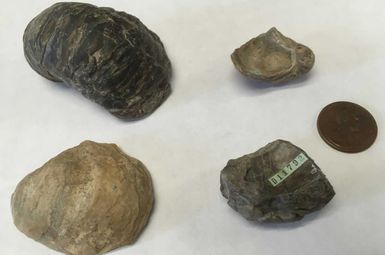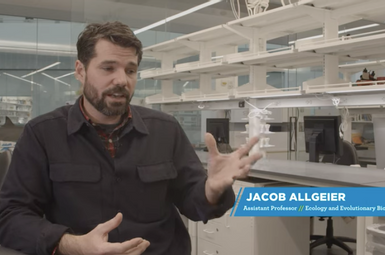
U-M has received a $25 million grant from the National Oceanic and Atmospheric Administration to support collaborative research initiatives addressing critical environmental challenges in U.S. coastal communities.

There are more than 228,000 marine species worldwide, ranging from seadragon to seaweed, according to the World Register of Marine Species. But there are a number of environmental stressors that impact the health and safety of aquatic life. Invasive species, for example, have changed the ecology of waterways and damaged critical industries like fisheries, agriculture and tourism, costing millions of dollars annually in control and mitigation. Researchers at the University of Michigan are partnering with communities, nonprofit organizations and government agencies to protect aquatic life, exploring important issues ranging from invasive species to fisheries management to habitat and wetland restoration.

U-M has received a $25 million grant from the National Oceanic and Atmospheric Administration to support collaborative research initiatives addressing critical environmental challenges in U.S. coastal communities.

Wetlands are threatened by a variety of factors, including nutrient runoff from lawns and agricultural operations. This excess of nutrients can promote the growth of invasive species and disrupt the delicate ecosystem balance.

A grant from the National Oceanic and Atmospheric Administration’s Integrated Ocean Observing System will establish a Great Lakes Biodiversity Observation Network to coordinate with and learn from biodiversity observation networks along the U.S. coasts and ocean waters and other BONs in ocean and freshwater habitats worldwide.

A team of scientists, including a U-M aquatic ecologist, is forecasting an above-average summer “dead zone” in the Gulf of Mexico covering about 5,827 square miles—an area roughly the size of Connecticut.

Great Lakes researchers at U-M have been awarded a $6.5 million, five-year federal grant to host a center for the study of links between climate change, harmful algal blooms and human health. Increased precipitation, more powerful storms and warming Great Lakes waters all encourage the proliferation of harmful algal blooms composed of cyanobacteria.

Michigan is home to 43 species of native freshwater mussels, 30 of which are considered to be at risk of extinction. Among the many factors that threaten the hard-shelled bottom dwellers are competition from invasive zebra and quagga mussels, water pollution, and—especially—dams.

When climate scientists look to the future to determine what the effects of climate change may be, they use computer models to simulate potential outcomes such as how precipitation will change in a warming world. But U-M scientists are looking at something a little more tangible: coral.

Rackham Ph.D. candidate Etienne Herrick-Sutton works with Great Lakes region farmers to identify strategies for improving the environmental and economic outcomes of cover cropping.

Six new research projects will investigate the shifting dynamics of harmful algal blooms, economic trends in coastal communities, emerging fish viruses, and other issues relevant to the Great Lakes.

The threat of harmful algal blooms (HABs) continues to plague Lake Erie, prompting intensified efforts from binational jurisdictions to address this persistent environmental challenge. Central to this endeavor is the mitigation of phosphorus, recognized as a key driver of algal blooms, through coordinated action plans.

A conservation easement permanently protects private land by limiting the type and amount of development on a property, and restricting other uses that would damage natural features such as rich soils and high functioning wetlands.

Since 1930, U-M has maintained the Edwin S. George Reserve (ESGR) to provide research and educational opportunities, as well as preserve native flora and fauna. The 525-hectare fenced ESGR is located in Livingston County, Michigan (about 25 miles northwest of Ann Arbor) and hosts students, postdocs and faculty as well as biologists from other universities throughout the year.

This summer’s Chesapeake Bay “dead zone” was the smallest it’s been since monitoring began in 1985, according to data released by the Chesapeake Bay Program’s monitoring partners: the Maryland Department of Natural Resources, Old Dominion University and Virginia Institute of Marine Science. The model used to make the annual forecasts was developed at U-M.

LSA’s Detroit River Story Lab teaches students from elementary school through college about the past and future of the vibrant body of water.

“Water management will be one of the challenges of our generation,” Gilchrist told students. “In order to understand how we can meet that challenge, we need smart, we need bold, we need connected information professionals to be part of the process.”

“Water conservation and access” brings a slew of images to mind: wastewater flowing through main lines to a city treatment plant, a fisherman yanking invasive mussels off the hull of a trawler, the installation of filters in communities that lack access to safely managed drinking water.

The tools and policies that worked to significantly reduce threats to the Great Lakes over the past century are ill-equipped to handle today’s complex and interrelated challenges. A new set of stewardship principles is needed to work holistically and systematically on long-term social, economic, environmental, and racial-equity and resiliency concerns that have too often been sidelined in a rush for immediate results.

An updated textbook has been released that provides a fundamental introduction to aquatic life and ecosystems and multidisciplinary fish studies, including an understanding of the anatomical, environmental, and ethological topics of fish ecology.

Lake Erie harmful algal blooms consisting of cyanobacteria, or blue-green algae, are capable of producing microcystin, a known liver toxin that poses a risk to human and wildlife health. Such blooms may force cities and local governments to treat drinking water and to close beaches, and they can harm vital local economies by preventing people from fishing, swimming, boating and visiting the shoreline.

In 2023, the dead zone is predicted to be 33% smaller than the long-term average taken between 1985 and 2022. If the forecast proves accurate, this summer’s Chesapeake Bay dead zone would be the smallest on record.

Discussions of valuable but threatened ocean ecosystems often focus on coral reefs or coastal mangrove forests. Seagrass meadows get a lot less attention, even though they provide wide-ranging services to society and store lots of climate-warming carbon.

A team of scientists including a U-M aquatic ecologist is forecasting a summer “dead zone” in the Gulf of Mexico that will cover an estimated 4,155 square miles, which is below the 5,364-square-mile average over the 36-year history of dead zone measurements in the region.

“I just thought it was an interesting story that this red alga looks so much like an animal, namely, a coral. It had been unnoticed as such, and then it turned out to have some distinctive features.”

State agencies and the U-M Water Center will work to understand and reduce Michigan’s nutrient runoff to Lake Erie, as well as design and implement a diverse, robust and transparent advisory process to inform the state’s adaptive management plan for the lake.
New information about an emerging technique that could track microplastics from space has been uncovered by U-M researchers. It turns out that satellites are best at spotting soapy or oily residue, and microplastics appear to tag along with that residue.

Mass coral bleaching events are making it harder for some species of reef fish to identify competitors, new research reveals. Scientists studying reefs across five Indo-Pacific regions found that the ability of butterfly fish individuals to identify competitor species and respond appropriately was compromised after widespread loss of coral caused by bleaching.

Dolphins and other sea creatures are affected by human disturbances in their habitat, including climate change, overfishing, noise pollution from shipping, construction, oil exploration and navy sonar activity. These types of disturbances can interrupt important animal behavior like foraging for fish and socializing, but measuring disturbance is difficult because the animals live under water.

This year’s Chesapeake Bay “dead zone” was the 10th-smallest observed since 1985, according to findings released today by the Chesapeake Bay Program and its partners, including U-M. The annual Chesapeake Bay dead zone is an area of low oxygen that forms in deep waters when excess nutrients, including both nitrogen and phosphorus, enter the water through polluted runoff and feed naturally occurring algae.

Fish excretions. Yes, that’s fish pee. Could it improve food security in the Caribbean? Allgeier thinks so, and it might even help slow global warming.

How can we boost the resilience of the world’s coral reefs, which are imperiled by multiple stresses including mass bleaching events linked to climate warming? One strategy advocated by some researchers, resource managers and conservationists is to restore populations of algae-eating reef fish, such as parrotfish. But a new study that analyzed long-term data from 57 coral reefs around the French Polynesian island of Mo’orea challenges this canon of coral reef ecology.

Katrina Munsterman, PhD student at U-M, recently became the recipient of a joint Sea Grant-NOAA Fisheries fellowship to pursue her work in ecosystem dynamics. Katrina applied via Michigan Sea Grant to receive this annual national award, the 2022 National Marine Fisheries Service (NMFS)-Sea Grant Joint Fellowship.

From the Great Lakes to its inland rivers and streams, hiking trails to golf courses, and lakeside cottages to campgrounds, the State of Michigan has long offered a near-endless number of natural resources to enjoy each summer—and a thriving tourism industry to prove it. But like with the rest of the country, and planet, the effects of climate change not only loom in the distance, but are here and causing real challenges to our ecosystem, and the outdoor recreation it provides, right now.

This summer’s Chesapeake Bay “dead zone” is expected to be smaller than the long-term average, according to a forecast released today by researchers from U-M, Chesapeake Bay Program, University of Maryland Center for Environmental Science and U.S. Geological Survey.

U-M has been awarded a five-year, $53 million renewal agreement from the federal government to continue and expand the Cooperative Institute for Great Lakes Research, with the goal of helping to conserve and manage the region’s natural resources.

The Detroit River Story Lab’s Skiff and Schooner Program is setting sail for its second summer, this time accommodating even more students in its quest to foster connection between the river and its communities. Students from 15 Detroit high schools, two colleges and six youth-serving organizations will board the schooner throughout the summer to learn about various topics focused on the environmental and cultural history of the Detroit River, ranging from marine biology and wildlife restoration to the Underground Railroad.

A team of scientists including a University of Michigan aquatic ecologist is forecasting a summer “dead zone” in the Gulf of Mexico of 5,364 square miles, about average for the 35-year history of the measurements. The forecast is lower than last year’s measured size and slightly lower than the five-year average measured size of 5,380 square miles. The 2022 Gulf of Mexico hypoxia forecast was released today by the National Oceanic and Atmospheric Administration, which funds the work.

Reducing levels of the nutrient phosphorus to control harmful algal blooms in places like Lake Erie is actually advantageous to toxic cyanobacteria strains, which can lead to an increase in toxins in the water, according to a new modeling study.

Researchers have identified many factors that influence the timing and distribution of Lake Erie’s harmful algal blooms. Intensity and timing of spring rainstorms is part of the puzzle, as is the amount of algae-feeding nitrogen and phosphorus traveling into the lake from nearby rivers.

A new U-M study that used fossil oyster shells as paleothermometers found the shallow sea that covered much of western North America 95 million years ago was as warm as today’s tropics. The findings also hint at what may be in store for future generations unless emissions of heat-trapping greenhouse gases are reined in.

More than 30 types of laboratory analyses will be performed on water and ice as part of a larger effort—dubbed the Winter Grab—to better understand winter on the Great Lakes, a season long dismissed by many scientists as a time of dormancy when little of importance happens.

Marine biologist and climate policy expert Dr. Ayana Elizabeth Johnson will deliver the Wege Lecture on Sustainability on February 23. Johnson is the co-founder of Urban Ocean Lab, a think tank for coastal cities, and co-creator (and former co-host) of the Spotify/Gimlet podcast “How to Save a Planet,” which discusses climate solutions.

Five newly awarded catalyst grants from the Graham Sustainability Institute will fund projects designed to advance potential infrastructure solutions across energy, transportation, and the built environment. The projects will facilitate climate change adaptation, test products aimed to reduce carbon emissions, and foreground equity and justice in sustainability interventions.

The Great Lakes support more than 3,500 species of plants and animals, including more than 170 species of fish, and a population of 34 million people in the United States and Canada who rely on these waters for recreation, employment, drinking water supply, and more.

Congresswoman Debbie Dingell (MI-12) toured the U-M Matthaei Botanical Gardens to showcase the success of the Great Lakes Fish and Wildlife Restoration Act and Great Lakes Restoration Initiative (GLRI) funds over the years and how the additional $1 billion included in the Bipartisan Infrastructure Law for the GLRI will help projects across the Great Lakes Basin for the long-term economic and environmental health of the region.

Jacob Allgeier, assistant professor of ecology and evolutionary biology, studies how nutrients and energy cycle through tropical ecosystems in order to better manage fisheries. The artificial reefs he’s building are an inexpensive, effective way to sustainably improve fisheries’ productivity.